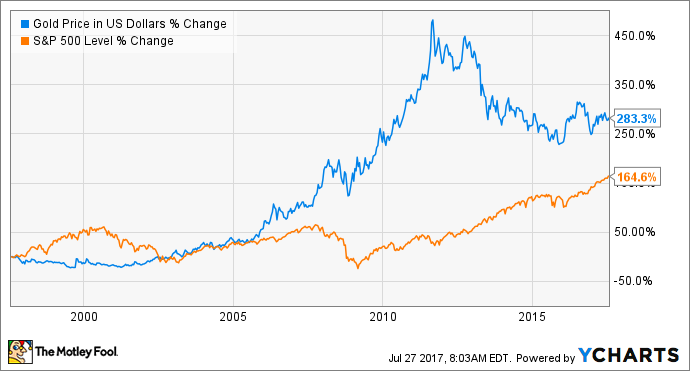With fear and uncertainty lurking in the headlines nearly every day, it's no wonder more investors are turning to gold -- even though gold has underperformed the market over the past 20 years. In that period, the S&P 500 has soared more than 280%, while gold has climbed only 165%. It's underperforming but still rising.
However, looking to the yellow metal doesn't just equate to buying some bullion or investing in a gold miner. Because royalty and streaming companies -- including Royal Gold (RGLD 0.76%) and Franco-Nevada (FNV -0.25%) -- offer a gold-investment opportunity that's insulated from the volatility in the price of gold to some degree, there's good reason to consider them for your portfolio.

Image source: Getty Images.
Let's get grounded
You read it in the news and hear it from the TV: Gold jumped today; gold dropped today. But what does that mean? Before we go any further, we should ground ourselves in some basics. When you hear about movements in the price of gold, it's a reference to the metal's spot price. Essentially, it's how much people are currently willing to pay for the metal right now. Attempting to benefit from the upward movement -- and mitigating the risk of market volatility -- you can buy gold on the commodities market, or you can buy gold bars and even gold coins.
Gold Price in US Dollars data by YCharts.
One way to gain exposure to gold is by buying shares through a gold ETF. The objective of the SPDR Gold Trust ETF (GLD 0.64%), for example, is to track the price of gold. Instead of holding companies, the gold ETF includes physical gold, and occasionally cash, as its holdings.
Digging in deeper
Another consideration is a gold-mining company. There are market leaders such as Barrick Gold (GOLD 1.12%), Newmont Mining Corp. (NEM 1.40%), and Goldcorp (GG), or smaller companies such as Yamana Gold (AUY). The argument goes like this: Companies mine the metal at a cost below the spot price, sell the gold for a profit, the market rejoices, and shares go up.
But this is reductive. Finding the yellow stuff and then digging it out of the ground doesn't come cheap, and miners often have to take on massive debt to keep the drills drilling.
Over the past 10 years, investors in mining companies -- even industry leaders -- have not only failed to see shares outperform the price of gold; they've failed to see shares break even.
Lustrous opportunities
So where else can investors turn for gold investments? That's where Royal Gold and Franco-Nevada come in.
As royalty and streaming companies, Royal Gold and Franco-Nevada provide upfront payments to the miners. In exchange, they receive the rights to purchase the mined metal at a preset price or to receive a percentage of mineral production. They're not directly involved with the mining of the mineral, so they're not weighed down by the substantial operating costs the miners incur. Furthermore, dips in the price of gold don't adversely affect the companies as much as it does gold miners, those who own bullion, or investors in gold ETFs.
It's clear, looking at their performances over the past 10 years, that Royal Gold and Franco-Nevada have been the best option for gold-oriented investors. Remember: Shares of all the mining companies I mentioned have failed to break even.
Of course, there's a difference between a company's stock price and a company's fundamentals. There are plenty of examples of companies whose stock prices have soared while their businesses have floundered, and vice versa. So let's examine why royalty and streaming businesses are better options than miners.
| Company | 5-Year Average Gross Margin | 5-Year Average Net Margin | 5-Year Average Return on Equity | 5-Year Average Quick Ratio | 5-Year Dividend Growth |
|---|---|---|---|---|---|
| Royal Gold | 90.4% | 16.5% | 2.08% | 24.1 | 63% |
| Franco-Nevada | 64.5% | 15.3% | 2.25% | 16.7 | 55% |
| Barrick Gold | 36.9% | (27.9%) | (22%) | 1.2 | (89%) |
| Goldcorp | 22.1% | (38.9%) | (8.7%) | 0.9 | (82%) |
| Newmont Mining Corp. | 44.2% | (2.2%) | (1.1%) | 1.5 | (91%) |
| Yamana Gold | (0.8%) | (42.8%) | (12.7%) | 0.5 | (92%) |
Data sources: Morningstar and author's calculations.
For one thing, royalty and streaming companies achieve better margins than their gold-mining cousins do. Having provided the upfront funding, Royal Gold and Franco-Nevada usually receive the right to purchase the mined gold for well below the spot price, ensuring they achieve high margins. Mining companies, however, are in a constant battle to reduce the expenses they incur while maintaining their operations. Furthermore, royalty and streaming companies report positive returns on equity, so investors can rest assured that their investments are put to good use.
Of course, both royalty and streaming companies as well as miners must contend with the price of gold in one way or another. A look at the company's quick ratios illustrate how Royal Gold and Franco-Nevada are well insulated from a rapid drop in the price of gold -- although the mining companies, for the most part, also seem to be in a decent position here.
Besides the clear difference in capital appreciation that separates the two groups of companies, there's a stark contrast in their dividend growth. Royal Gold and Franco-Nevada have consistently rewarded shareholders with rising dividends over the past five years; however, mining companies have had to slash their payments.
Investor takeaway
There seems to be no end in sight for news stories that portend volatility in the markets. But investors who consider royalty and streaming companies have a little less to fear. Not only does their exposure to gold mitigate their risk, but the nature of their business affords them the opportunity to outperform the price of gold -- and possibly the market in general.








